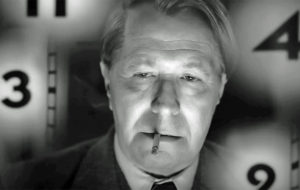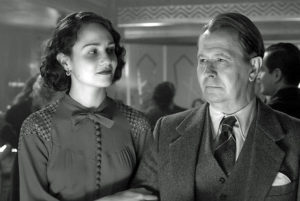 By Steve Crum
By Steve Crum
Herman J. Mankiewicz aka “Mank” (1897-1953), the titular focus of the fascinating film Mank, was a major writing force in Hollywood—even though not always credited as such. It was almost that way with his Oscar winning screenplay for 1941’s Citizen Kane. The classic movie’s backstory is covered with penetrating detail in Mank.
The only drawback is the film covers Hollywood history unfamiliar to most moviegoers. It’s pretty inside. Others—like yours truly—will savor every minute.
The 131-minute film, directed by Oscar nominated David Fincher (The Curious Case of Benjamin Button, The Social Network), pays considerable homage its plot focus, Citizen Kane. That includes frequent flashback sequences, some attention to the Orson Welles use of camera angles and closeups, and shooting in black and white. As with Citizen Kane and other era films, night scenes were shot during the day (called “day for night”) and darkly filtered to imply night. Modern digital cameras have made it possible to film in near darkness.
 Fincher and his cinematographer, Erik Messerschmidt, were painstaking in the their successful effort to simulate/duplicate the visuals of Citizen Kane’s 1941 look.
Fincher and his cinematographer, Erik Messerschmidt, were painstaking in the their successful effort to simulate/duplicate the visuals of Citizen Kane’s 1941 look.
In this respect, bravos go to editor Kirk Baxter and screen scribe Jack Fincher. Interestingly, Jack Fincher wrote the screenplay in the late 1990s, when his son David was originally planning to produce Mank. Sadly, Jack died in 2003.
But now Mank is finally produced, telling the fascinating and often disturbing story of Herman Mankiewicz’s association with Orson Welles in the production of what many consider the greatest film of all time, Citizen Kane. As depicted in Mank, Welles (Tom Burke) has been complete freedom to film whatever he so desires at RKO. (Oddly, there is little if no mention of why he has such carte blanche. It was because he had made international news with his War of the Worlds radio sensation.) Welles was the “boy genius,” and he chose Mankiewicz to write a scathing, brilliant epic about publishing magnate William Randolph Hearst—disguised as Charles Foster Kane.
 After all, as told in flashbacks, Mankiewicz had been a friend of Hearst’s lover, Marion Davies, for years. He was also a frequent guest at Hearst Castle, so he knew the man quite well. (Davies is portrayed by Amanda Seyfried; Charles Dance plays Hearst.)
After all, as told in flashbacks, Mankiewicz had been a friend of Hearst’s lover, Marion Davies, for years. He was also a frequent guest at Hearst Castle, so he knew the man quite well. (Davies is portrayed by Amanda Seyfried; Charles Dance plays Hearst.)
It was no surprise that Hearst fought against the release of Citizen Kane, and even had a ban on advertising the film in his newspapers and magazines. (It suffered financially, but not critically—in non-Hearst media.)
Mank’s focus is on the struggles of Herman Mankiewicz as he constantly deals with alcoholism while trying to meet script deadlines. In the process, he encounters the likes of MGM’s head, Louis B. Mayer (Arliss Howard), producer (and much later actor) John Houseman (Sam Troughton), and Irving Thalberg (Ferdinand Kingsley). On a lighter note, look for Bill Nye (“The Science Guy”) as writer and political activist Upton Sinclair.
producer (and much later actor) John Houseman (Sam Troughton), and Irving Thalberg (Ferdinand Kingsley). On a lighter note, look for Bill Nye (“The Science Guy”) as writer and political activist Upton Sinclair.
Very closely involved with Mank’s health and well being are his wife Sara (Tuppence Middleton) and brother, writer/director Joe Mankiewicz (Tom Pelphrey).
A particularly memorable scene involves a drunken Mank crashing a costumed dinner party in the great dining  hall at Hearst Castle, and creating a scene that includes broken glass, embarrassment, anger, and vomiting. How much this sequence is based on fact is speculative unto itself. However, it is believable.
hall at Hearst Castle, and creating a scene that includes broken glass, embarrassment, anger, and vomiting. How much this sequence is based on fact is speculative unto itself. However, it is believable.
Above all else in Mank, super kudos go to the remarkably talented Gary Oldman, who stuns as Herman Mankiewicz. Oldman has never gotten the deserved credit for his ability to convincingly portray a wide range of personalities. From Count Dracula to Winston Churchill to Beethoven to Sid Vicious to Lee Harvey Oswald, the Oscar winning Oldman became them in total. In 106 movies and TV shows, he gets my vote for the most transformational artist in movie history. That includes the brilliant work of Lon Chaney Sr., Christian Bale, Paul Muni, and Daniel Day-Lewis.
At the very least, when Mank is released on DVD, it should be paired with Citizen Kane in a boxed set. Each would complement the other.
∞∞∞∞∞
GRADE on an A-F Scale: A-
